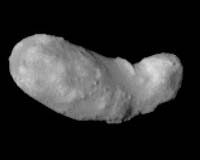 |
Tel Aviv, Israel (UPI) Sep 13, 2010 Asteroids made of gravel-sized rocks held together by gravity could hit the Earth like a shotgun blast rather than a single cannonball, Israeli researchers say. It was long theorized that these "rubble pile" asteroids, if they spun fast enough, could throw off material through centrifugal force to create a second collection of rocks -- a "separated" twin -- that would spin around the sun in the exact same orbit. Now researchers at Tel Aviv University, using the school's Wise Observatory deep in the Negev Desert, have proved the existence of these theoretical "separated asteroid" pairs, a university release said Monday. David Polishook and Noah Brosh of the school's Department of Geophysics and Planetary Sciences say the research has not only verified a theory, but could have implications if such an asteroid passes close to Earth. Instead of a giant solid rock colliding with the Earth's surface, Brosch says, the planet would be pelted with the innumerable pebbles and rocks that make up one of these asteroids. This knowledge could make a difference in the defensive tactics to be considered if an asteroid were on a collision course with Earth, the researchers say.
Share This Article With Planet Earth
Related Links Asteroid and Comet Mission News, Science and Technology
 Asteroid Cornucopia
Asteroid CornucopiaPasadena CA (SPX) Sep 09, 2010 New research from NASA's Spitzer Space Telescope reveals that asteroids somewhat near Earth, termed near-Earth objects, are a mixed bunch, with a surprisingly wide array of compositions. Like a pinata filled with everything from chocolates to fruity candies, these asteroids come in assorted colors and compositions. Some are dark and dull; others are shiny and bright. The Spitzer observatio ... read more |
|
| The content herein, unless otherwise known to be public domain, are Copyright 1995-2010 - SpaceDaily. AFP and UPI Wire Stories are copyright Agence France-Presse and United Press International. ESA Portal Reports are copyright European Space Agency. All NASA sourced material is public domain. Additional copyrights may apply in whole or part to other bona fide parties. Advertising does not imply endorsement,agreement or approval of any opinions, statements or information provided by SpaceDaily on any Web page published or hosted by SpaceDaily. Privacy Statement |